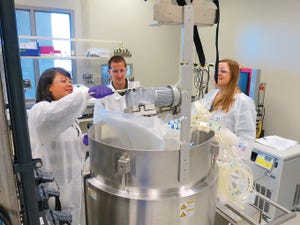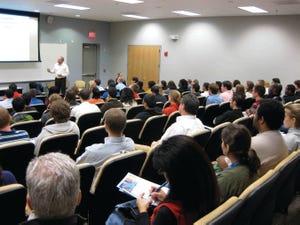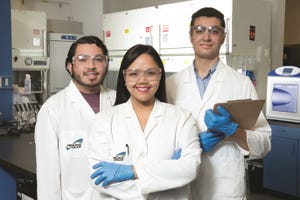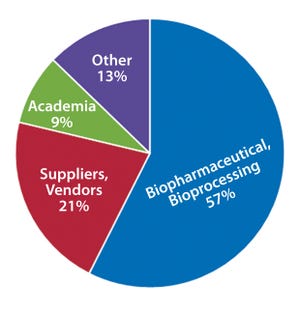December 2016 Supplement
Over the years, the
BioProcess International
special supplements have tackled a large number of important topics on emerging trends and new technologies in biomanufacturing, including single-use technologies, continuous manufacturing, cell therapies, and outsourcing. As these and other issues continue to arise and play a critical role in the development of the biopharmaceutical industry, the success of the biomanufacturing industry relies on its ability to attract and retain a well-trained and motivated workforce that can adapt to new technologies and manufacturing challenges.
Recognizing the critical importance of a highly-skilled workforce, the biopharmaceutical industry has played a vital role in making sure education and training initiatives receive the funding necessary to add value, remain relevant, and maintain the capacity to educate the biopharmaceutical industry’s future scientific and technical leaders. In North Carolina, industry’s voice played a central role in establishing North Carolina S...
TEC’s career fair emphasizes the importance of collaborative and interactive approaches to biopharmaceutical training and industry education. (www.btec.ncsu.edu)
As in most high-tech sectors, success within the highly regulated biopharmaceutical manufacturing industry depends upon an adaptable, skilled, educated, and high-performing workforce. The impact of human performance cuts across the entire industry — whether for a manufacturing operator, a scientist or engineer in a highly technical role such as process development, or a technical sales representative serving the industry.
The effects of poor performance can be seen easily in deviation reports and FDA warning letters as well as in quantified productivity metrics surrounding time to proficiency, yield, revenue, employee engagement, and retention. Although many factors influence human performance, a lack of appropriate training is far too often cited as a root cause.
Further, new technologies are creating potentially disruptive changes within the in...
Hands-on training for upstream processing (www.btec.ncsu.edu)
To begin the discussions in this issue about structuring successful training programs, these authors describe how to develop in-house resources. Both emphasize the need to assess the impact of previous training approaches. An important factor is to understand that students will bring varying levels of knowledge and relevant experience to their work with your company. So how do you structure a training program that takes into account individual learning styles and operational expertise? How to you measure the successful application of training to performance? As a manager, how can you confirm that reading training materials has truly led to required levels of understanding within your group? And how long can you realistically expect employees to spend watching a training video before their attentions wander?
At the March 2016
BioProcess Theater at Interphex
in New York City, Chad Cooper, Biogen’s director of performance development, and David ...
Assessing the need for training that addresses the varied needs of your employees requires looking far beyond a one-size-fits-all approach. Few companies, however, have the internal resources to develop truly comprehensive programs on their own. Successful training approaches are those that enable end-users, organizations, and suppliers to share needed equipment and expertise.
At the 2016 BioProcess Theater at Interphex, Gary Gilleskie (BTEC’s director of operations) and Scott Sommer (a technical fellow at Renmatix) detailed examples of successful training programs for new and emerging technologies. Below, Gilleskie describes BTEC’s successful approach for training in single-use technologies, and Sommer explains the importance of improving the quality of and access to automation training and existing certification programs.
Photo 1: Short course participants learn about disposable bioreactors at BTEC.
Process-Oriented Training in Single-Use Technology
by Gary Gilleskie
At the
2016 BioProcess Theater
, Ga...
BTEC produced this meeting of ISPE’s NCSU student chapter, in which many of Biogen Idec’s professionals participated. (www.btec.ncsu.edu)
Well-designed education, training, and professional development programs and partnerships add considerable return on investment to stakeholders across the biopharmaceutical manufacturing industry. As biomanufacturers, suppliers, and regulatory bodies share similar workforce needs, focused education and training efforts can lead to increases in productivity, yield, and employee engagement and retention. In addition, education and training programs can decrease the incidence of deviations, which are costly to investigate and remediate. Yet when compared with other business needs, training, development, and human performance initiatives are all too often undervalued by leadership. Generating momentum for effective learning and development initiatives hinges on involvement from the right stakeholders.
In hopes of shedding light on the value of such training investments, thi...
Students in the Master of Microbial Biotechnology (MMB) program at NCSU.
Undergraduate and/or graduate programs in physical and life sciences can provide a solid background for science and engineering students who are interested in careers in biotechnology research and development. Yet many such programs have not adequately prepared students for careers within and related to the biopharmaceutical industry.
In today’s globally competitive job market, developing a workforce pipeline for the bioprocess industry requires academic programs that equip students with knowledge, skills, and theory surrounding the equipment, methodologies, processes, and regulatory requirements specific to it. Informed graduates are better able to manage their own career expectations, understand job requirements, and get their “foot in the door.”
Universities, community colleges, and even high schools have recognized the need for a college-educated and highly skilled workforce and have worked to develop industry-focused academic mo...
Figure 1A: Survey respondents represent a number of different organization types
Training is an investment. And it’s one that the authors, contributors, and other individuals behind this supplement understand well. However, the biopharmaceutical industry is much larger than these few individuals. It’s just as important to understand the motivators, drivers, and training-related challenges faced by the industry at large.
So BPI and BTEC jointly administered a short survey to gather some basic information from the magazine’s readership about the value and role that training plays in their organizations.
Figure 1B: Survey respondents represent a number of different job functions
According to survey respondents, professional development programs serve a range of purposes: e.g., driving increases in productivity, reducing deviations, increasing employee engagement, and increasing the overall technical skill base of the workforce.
Yet despite a great amount of common agreement about those benefits, nearly half ...











